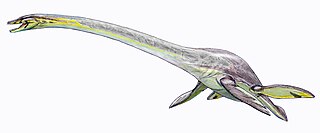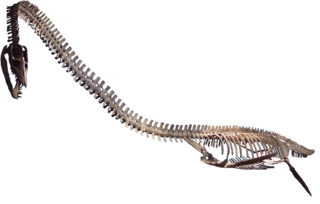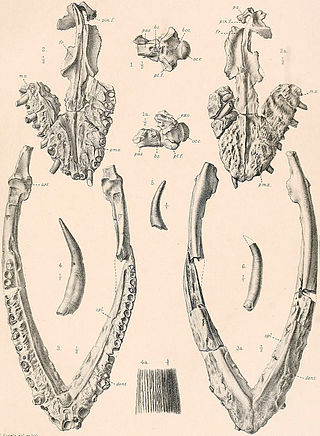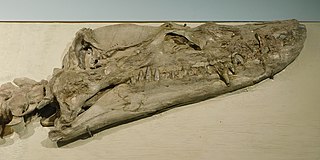
Plesiosauroidea is an extinct clade of carnivorous marine reptiles. They have the snake-like longest neck to body ratio of any reptile. Plesiosauroids are known from the Jurassic and Cretaceous periods. After their discovery, some plesiosauroids were said to have resembled "a snake threaded through the shell of a turtle", although they had no shell.

Elasmosaurus (;) is a genus of plesiosaur that lived in North America during the Campanian stage of the Late Cretaceous period, about 80.5 million years ago. The first specimen was discovered in 1867 near Fort Wallace, Kansas, US, and was sent to the American paleontologist Edward Drinker Cope, who named it E. platyurus in 1868. The generic name means "thin-plate reptile", and the specific name means "flat-tailed". Cope originally reconstructed the skeleton of Elasmosaurus with the skull at the end of the tail, an error which was made light of by the paleontologist Othniel Charles Marsh, and became part of their "Bone Wars" rivalry. Only one incomplete Elasmosaurus skeleton is definitely known, consisting of a fragmentary skull, the spine, and the pectoral and pelvic girdles, and a single species is recognized today; other species are now considered invalid or have been moved to other genera.

The Plesiosauria or Plesiosaurs are an order or clade of extinct Mesozoic marine reptiles, belonging to the Sauropterygia.

Elasmosauridae is an extinct family of plesiosaurs, often called elasmosaurs. They had the longest necks of the plesiosaurs and existed from the Hauterivian to the Maastrichtian stages of the Cretaceous, and represented one of the two groups of plesiosaurs present at the end of the Cretaceous alongside Polycotylidae. Their diet mainly consisted of crustaceans and molluscs.

Muraenosaurus is an extinct genus of cryptoclidid plesiosaur reptile from the Oxford Clay of Southern England. The genus was given its name due to the eel-like appearance of the long neck and small head. Muraenosaurus grew up to 5.2 metres (17 ft) in length and lived roughly between 160 Ma and 164 Ma in the Callovian of the middle Jurassic. Charles E. Leeds collected the first Muraenosaurus which was then described by H. G. Seeley. The specimen may have suffered some damage due to the casual style of Charles Leeds’ collection. The first muraenosaur was recovered with pieces missing from the skull and many of the caudal vertebrae absent. Because the animal was described from Charles Leeds’ collection it was given the name Muraenosaurus Leedsi. M. leedsi is the most complete specimen belonging to the genus Muraenosaurus and also the only species that is undoubtedly a member of the genus. Two other species have been tentatively referred to as members of the genus Muraenosaurus: M. reedii and Muraenosaurus beloclis Seeley 1892, which in 1909 became the separate genus Picrocleidus.
Tuarangisaurus is an extinct genus of elasmosaurid known from New Zealand. The type and only known species is Tuarangisaurus keyesi, named by Wiffen and Moisley in 1986.

Aphrosaurus was an extinct genus of plesiosaur from the Maastrichtian. The type species is Aphrosaurus furlongi, named by Welles in 1943. The holotype specimen was discovered in the Moreno Formation in Fresno County, California in 1939 by rancher Frank C. Piava. A second specimen - LACM 2832 - was also found in the same formation and initially diagnosed as a juvenile of the same species, but has since been removed from the genus.
Terminonatator is a genus of elasmosaurid plesiosaur from the Late Cretaceous of Saskatchewan, Canada. It is known from a skull and partial skeleton from a young adult, found in the Campanian-age Bearpaw Formation near Notukeu Creek in Ponteix. Terminonatator is currently one of the youngest plesiosaurs from the Western Interior Seaway.

Styxosaurus is a genus of plesiosaur of the family Elasmosauridae. Styxosaurus lived during the Campanian age of the Cretaceous period. Two species are known: S. snowii and S. browni.
Paleontology or palaeontology is the study of prehistoric life forms on Earth through the examination of plant and animal fossils. This includes the study of body fossils, tracks (ichnites), burrows, cast-off parts, fossilised feces (coprolites), palynomorphs and chemical residues. Because humans have encountered fossils for millennia, paleontology has a long history both before and after becoming formalized as a science. This article records significant discoveries and events related to paleontology that occurred or were published in the year 1950.

Callawayasaurus is a genus of plesiosaur from the family Elasmosauridae. When the holotype was first described by Samuel Paul Welles in 1962, it was described as Alzadasaurus colombiensis before being moved into its current genus by Kenneth Carpenter in 1999.
Eromangasaurus is an extinct genus of elasmosaurid known from northern Queensland of Australia.

Alexandronectes is a genus of elasmosaurid plesiosaur, a type of long-necked marine reptile, that lived in the oceans of Late Cretaceous New Zealand. It contains one species, A. zealandiensis. Fossils of Alexandronectes were found in the Conway Formation of Canterbury, which can be dated to the Early Maastrichtian stage of the Cretaceous. Fossils of it were found around 1872 near the Waipara River, north of Christchurch, New Zealand.

Albertonectes is an extinct genus of elasmosaurid plesiosaur known from the Late Cretaceous Bearpaw Formation of Alberta, Canada. It contains a single species, Albertonectes vanderveldei. Albertonectes is the longest elasmosaur, and more generally plesiosaur, known to date both in neck and total body length.

This timeline of plesiosaur research is a chronologically ordered list of important fossil discoveries, controversies of interpretation, taxonomic revisions, and cultural portrayals of plesiosaurs, an order of marine reptiles that flourished during the Mesozoic Era. The first scientifically documented plesiosaur fossils were discovered during the early 19th century by Mary Anning. Plesiosaurs were actually discovered and described before dinosaurs. They were also among the first animals to be featured in artistic reconstructions of the ancient world, and therefore among the earliest prehistoric creatures to attract the attention of the lay public. Plesiosaurs were originally thought to be a kind of primitive transitional form between marine life and terrestrial reptiles. However, now plesiosaurs are recognized as highly derived marine reptiles descended from terrestrial ancestors.

Megacephalosaurus is an extinct genus of short-necked pliosaur that inhabited the Western Interior Seaway of North America about 94 to 93 million years ago during the Turonian stage of the Late Cretaceous, containing the single species M. eulerti. It is named after its large head, which is the largest of any plesiosaur in the continent and measures up to 1.75 meters (5.7 ft) in length. Megacephalosaurus was one of the largest marine reptiles of its time with an estimated length of 6–9 meters (20–30 ft). Its long snout and consistently sized teeth suggest that it preferred a diet on smaller-sized prey.

Kawanectes is a genus of elasmosaurid plesiosaur, a type of long-necked marine reptile, that lived in the marginal marine environment of Late Cretaceous Patagonia. It contains one species, K. lafquenianum, described in 2016 by O'Gorman.

Nakonanectes bradti is an elasmosaurid plesiosaur of the late Cretaceous found in 2010 the state of Montana in the United States. It is one of the most recently known elasmosaurids to have lived in North America. Unlike other elasmosaurids, it has a relatively short neck.

Lagenanectes is a genus of elasmosaurid plesiosaur from the Lower Cretaceous, found in Lower Saxony, Germany. The only species, Lagenanectes richterae, was first described in 2017, and is regarded as one of the best-preserved plesiosaur fossils from this geological age in Europe. Lagenanectes is one of the earliest elasmosaurids. The holotype is an incomplete skeleton, comprising large parts of the skull, some neck and tail vertebrae as well as ribs and part of the limbs. A length of about 8 meters has been estimated.
Paleontology or palaeontology is the study of prehistoric life forms on Earth through the examination of plant and animal fossils. This includes the study of body fossils, tracks (ichnites), burrows, cast-off parts, fossilised feces (coprolites), palynomorphs and chemical residues. Because humans have encountered fossils for millennia, paleontology has a long history both before and after becoming formalized as a science. This article records significant discoveries and events related to paleontology that occurred or were published in the year 2017.























